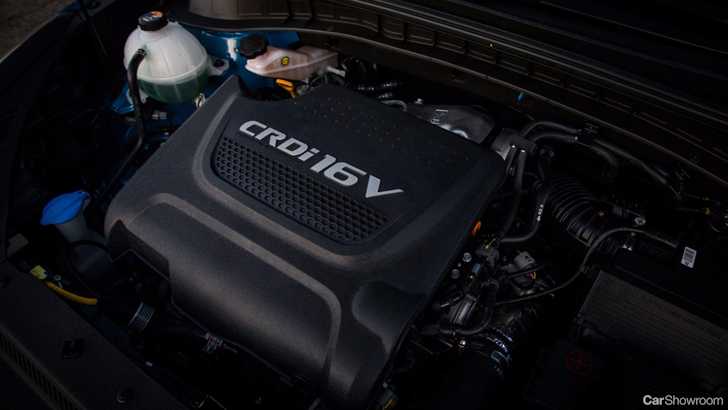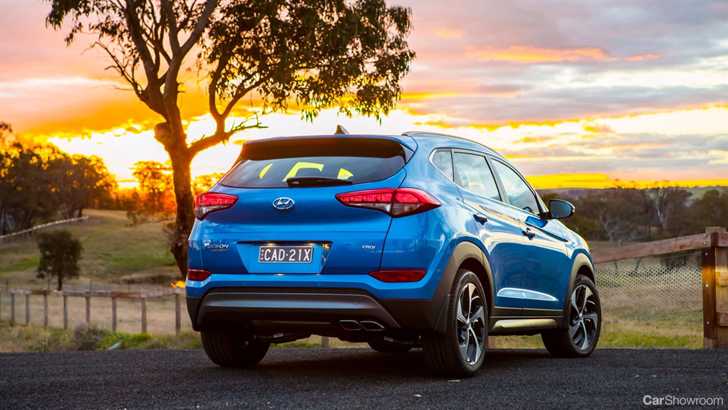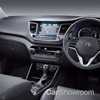The Tucson is Hyundai’s mid-size five-seater SUV. It combines sharp looks, comfort, and a good amount of standard equipment to impress anyone looking at this type of vehicle, which is a tall order given just how competitive a landscape it’s asked to flourish in.
That requires a clear advantage, preferably in one particular aspect, over the slew of strong contenders. Being an all-rounder is harder still, but Hyundai has managed to craft a more-than-worthy class frontrunner that’s also quite good value.
Specifically, it competes with the Mazda CX-5, Kia Sportage, Nissan Qashqai, Honda CR-V, Ford Escape, and Volkswagen Tiguan for top honours as the go-to pick for a practical family runabout.
Introduced in late 2015 after being first unveiled at the Geneva Motor Show earlier that year, this third-generation Tucson is the most visually and technically accomplished yet in addition to being covered by Hyundai’s unlimited-mileage 5-year warranty, so you’re to be covered should anything go wrong with said technical bits.
Four grades make up the range - the Active, Active X, Elite, and Highlander. The two lower-spec models receives naturally-aspirated engines and front-wheel drive, while all-wheel drive and the gutsier and more efficient turbocharged engines are reserved for those willing to shell out extra for the Elite or Highlander.
Exterior
“It’s a cleaner design than the edgy and overdone ix35, now presenting smoother lines and cleaner surfaces.” - CarAdvice
It’s one of the better looking compact SUVs out there, though it manages this in a more subtle manner. Hyundai has festooned it with plenty of the brand’s little design cues, but it looks more sorted and congruent here on the Tucson. It doesn’t defy convention and in some areas one might hear echoes of conservatism, but on the whole it’s a well thought out and attractive design.
There’s the typical creases that run the length of the car, but they aren’t too pronounced, and the accented angularity here is harmonised by the softly curving basic shape. It’s front grille is the hexagonal gape that’s typical of newer Hyundais, but it’s put to better effect on the Tucson perhaps by virtue of its raised height bringing it into more prominent view.
The largest available 19-inch alloys are flashy, but tastefully so, in the Elite and Highlander. But even in lower grade models, the smaller 17- and 18-inchers do little to really temper the Tucson’s good looks.
Engine and Drivetrain
“The engine/transmission package is efficient, quiet and friendly, leading to stress-free motoring.” - CarsGuide
Both the Active and Active X have 2.0-litre petrol engines under their bonnet which end up spinning the front wheels. Despite having identical displacements, they aren’t of equal measure, however.
The entry-level version receives a less sophisticated MPi (Multi-Point Injection) motor with 114kW and 192Nm while the step up GDi (Gasoline Direct Injection) engine serves up 121kW and 203Nm.
The Elite kicks off the first of two all-wheel drive Tucsons, which is an ‘Active On-Demand’ system that usually operates as a front-driven car for greater fuel efficiency but can split torque up to 50:50 to the rear axle should the need arise. Still, don’t expect the Hyundai to suddenly be able to scale mountains. This is still a ‘soft-roader’ through and through.
First up for the all-wheel drive versions is the 1.6-litre T-GDi four-cylinder turbocharged petrol engine which it also shares with the Veloster. Power is identical at 130kW and 265Nm from as early 1,500rpm.
Finally, there’s a 2.0-litre CRDi diesel that outputs 136kW and uses a variable turbine geometry turbo to work up 400Nm of torque available from 1,750rpm. It’s also the most economical at a claimed 6.4-litres/100km while the rest of the petrols manage, at best, 7.7-litres/100km.
There are three transmissions with only the Active and Active X getting the option of having a six-speed manual in addition to an automatic with the same number of forward ratios. The two higher-end grades only come as automatics, though the 1.6-litre turbo-petrol is mated exclusively to a 7-speed dual clutch in contrast to the 6-speed auto used in the rest of range.
Interior
“Interior quality has taken a big step forward too with the overall fit and finish easily rivaling anything with a Volkswagen badge.” - AutoExpress
It would have been nice if they had some of the Tucson’s attractive exterior flourishes echoed inside. But we know Hyundai is more adept at functional interiors rather than those that necessarily bewitch immediately, and that narrative continues in here.
It’s a decently styled, smart-looking cabin that scores high on ergonomics, a little less so on materials, but gives a surprisingly strong showing in build quality. Everything is well laid out, yes, and surfaces near the top have been given an assuredly soft-touch but solid feel.
However, these might not matter as much as space does to the type of buyer the Tucson and its contemporaries really hold dear. Here, the Hyundai again delivers - not cramped by any means, and outright expansive-seeming should the panoramic roof be optioned.
In the second row, three adult passengers can sit abreast without issue, and even with that glass roof, headroom is ample - having it adds only eats up 10mm. The clever packaging also means there’s a generous amount of knee room. That’s interrupted slightly by a transmission hump, but its unobtrusive enough to be practically negligible.
The boot can expand to 1,478-litres with the seats folded to their helpfully flat position, but with them left up 488-litres are available to swallow the family’s weekend luggage or a some bulk-buying at the grocery store.
Behind The Wheel
“There’s little in the way of feedback through the steering, though, and the woollen feel around the dead-ahead is a further negative, but it’s otherwise precise and well-weighted.” - Autocar
One may reasonably expect the Tucson’s on-road demeanour to closely mirror that of its sister car, the Kia Sportage, and that’s only half way to being true. Like the Kia, the Tucson does have a sophistication to the way it rides that almost feels European.
Unlike the Sportage, though, this sense of poise is more evident in the Tucson due to its softer suspension tune. Not only does the Hyundai look like a larger SUV, it gives the impression of being a more substantially weighted car, though without the drawbacks actually being heavy. It’s more solidity than heft, really. Mind you, the largest wheel options do tend to add an hard edge to bumps and craggily roads.
Steering, though, is contrarily light and quick, reminiscent of a typical hatchback, which can make small twitches more substantial at higher speed. Certainly, staying on some higher profile tyres, this lends the Tucson to being a capable motorway cruiser, a purpose Hyundai seemed to have intentioned judging by the well insulated cabin and lack of wind noise.
Those who choose the more expensive variants with all-wheel drive can have the added security of all-weather grip and modest off-road traversal ability, though outside of these kinds of circumstances the 2WD Tucsons feel just as planted thanks to its multi-link rear suspension, we suspect.
Safety and Technology
“For high-tech safety it’s necessary to step up to the more expensive Tucsons.” - Motoring
Hyundai will never (most likely) let their cars achieve anything less than full marks in safety tests. In the usual crash deformation and occupant safety trials that ANCAP runs a car through - quite literally - it scores 5-stars, their maximum score.
All Tucsons are equipped with stability control, anti-lock brakes, traction control, hill-start assist, rear parking sensors and a reversing camera. Though only the Highlander comes with the more advanced ‘active’ safety tech such as Autonomous Emergency Braking (AEB), Lane Keep Assist, Lane Departure Warning, Blind Sport Monitoring, and Rear Cross Traffic Alert. There’s keyless entry too, but proximity-activated push button start is only on the two top grades.
There are audio multifunction controls as standard, though the spread of infotainment solutions are divided into either a 7-inch system with 6 speakers and compatibility with Apple CarPlay on the lower-spec Active and Active X. Pay more for the Elite or Highlander, though, and the panel size increases to 8-inches and adds satellite navigation. CarPlay smartphone support, though, is lost.
Verdict
The Tucson is Hyundai’s more mature, sophisticated alternative to the Kia Sportage. They do indeed share quite a bit under the skin, though you’d be hard-pressed to realise this given how differently they feel.
Still, the Tucson isn’t relegated to being the boring choice. It’s styled quite handsomely, equipped generously, built well, and even manages to impress on the road in comparison to other class competitors. Sure, the Mazda CX-5 drives better and the Volkswagen Tiguan is more luxurious, but to the Hyundai’s credit, it’s more comfortable than the Mazda and a fair bit less expensive than the VW without being compromised on either fronts. Well done.
AutoExpress - 4/5 - “The Hyundai Tucson revived an old name, but everything about the latest model is fully up-to-date. It faces some very stiff opposition in the shape of cars such as the Renault Kadjar, Kia Sportage and SEAT Ateca, but the Hyundai Tucson competes well on most levels.”
CarAdvice - 8/10 - “In terms of a family friendly SUV, the Tucson is pretty darn good. Is it better than a Mazda CX-5? It’s hard to say, nonetheless it will happily suit families of four and there is 513L of space in the boot, which is enough to take a large pram and other necessities.”
CarsGuide - 4/5 - “Setting aside the fact that the Hyundai Tucson ActiveX makes do with front-wheel drive as opposed to all-wheel power distribution, it is worthy of its medium-size SUV upgrade through space, and quality and range of specification.”
Motor Trend - 4/5 - “The Tucson’s interior is also a strong point, offering plenty of available tech, good build quality, and abundant space for front and rear occupants. This makes the Tucson excellent value because it comes with a slew of available features, yet it costs less than some of its competitors.”
Motoring - 71/100 - “…it’s hard to attach many negatives to the new Hyundai Tucson. Two generations away from the original model that appeared in 2004 – even offering a 2.7-litre V6 option – and a distinct leap over the previous ix35, the reincarnated Tucson sits comfortably in the short list of truly aspirational mid-size SUVs.”
Autocar - “Those in the market for a crossover should definitely consider the smart, capable, practical and likeable Tucson.”




































